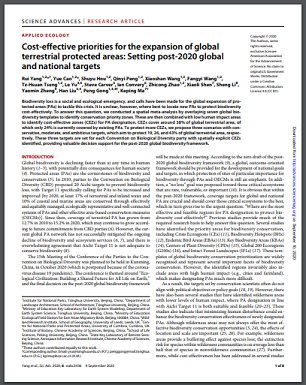
Biodiversity loss is a social and ecological emergency, and calls have been made for the global expansion of protected areas (PAs) to tackle this crisis. It is unclear, however, where best to locate new PAs to protect biodiversity cost-effectively. To answer this question, we conducted a spatial meta-analysis by overlaying seven global biodiversity templates to identify conservation priority zones. These are then combined with low human impact areas to identify cost-effective zones (CEZs) for PA designation. CEZs cover around 38% of global terrestrial area, of which only 24% is currently covered by existing PAs. To protect more CEZs, we propose three scenarios with conservative, moderate, and ambitious targets, which aim to protect 19, 26, and 43% of global terrestrial area, respectively. These three targets are set for each Convention on Biological Diversity party with spatially explicit CEZs identified, providing valuable decision support for the post-2020 global biodiversity framework.














